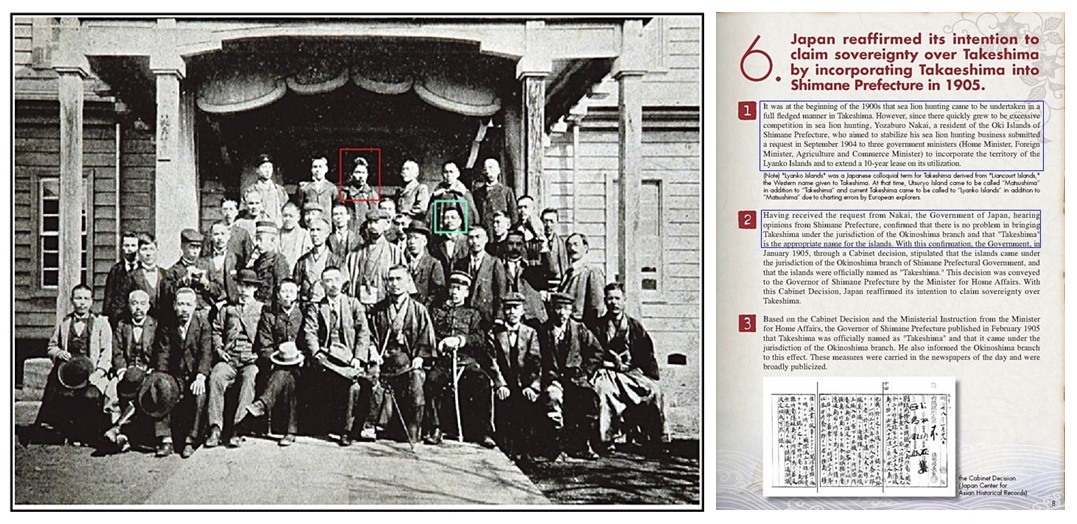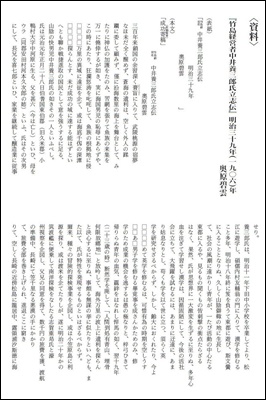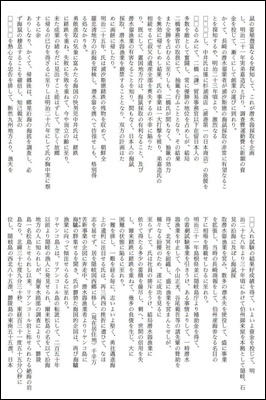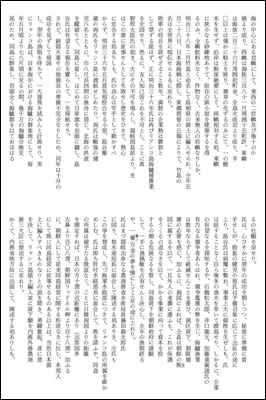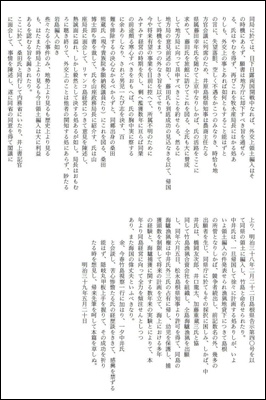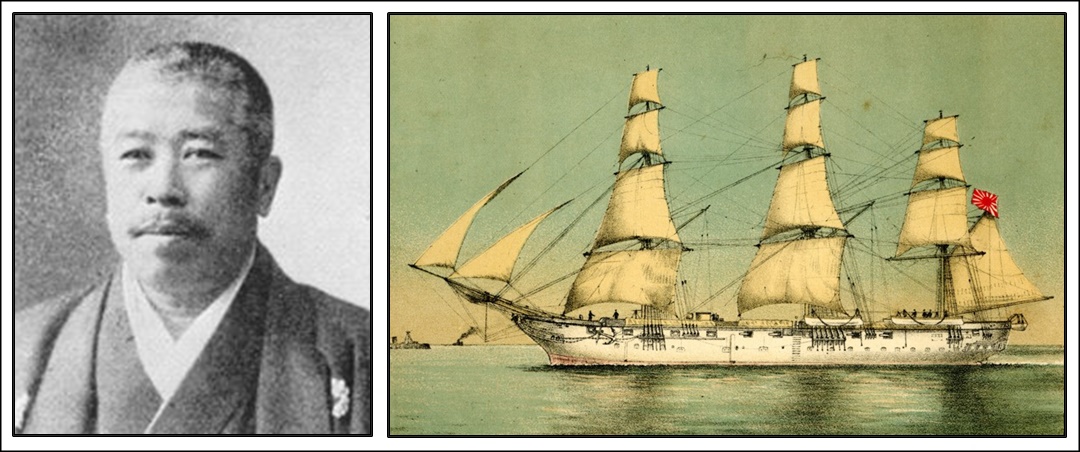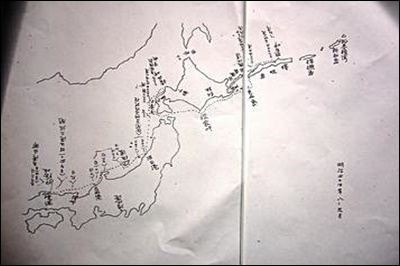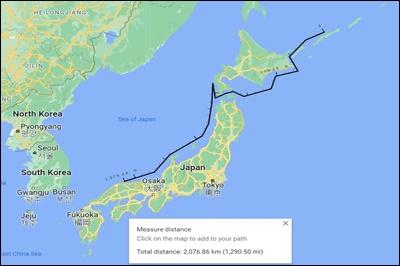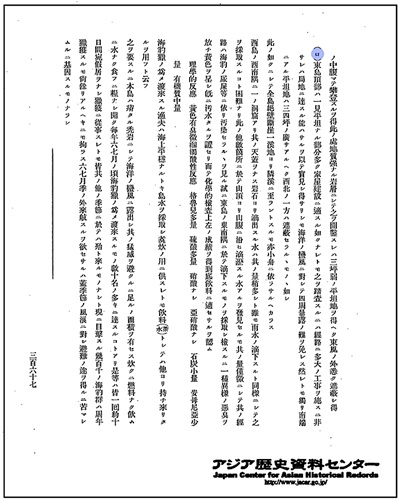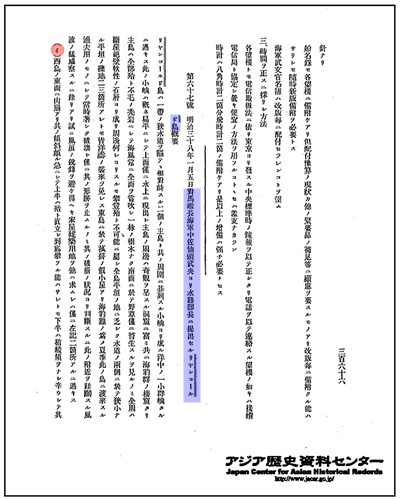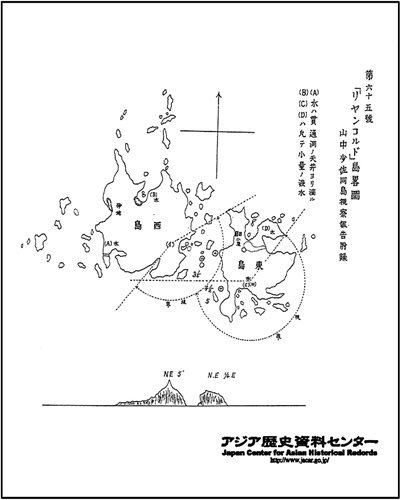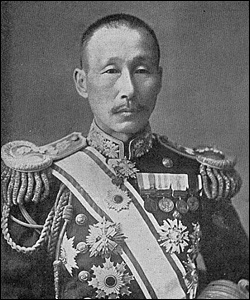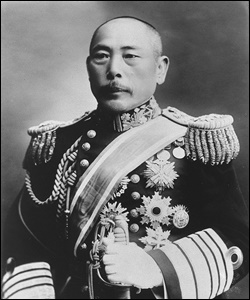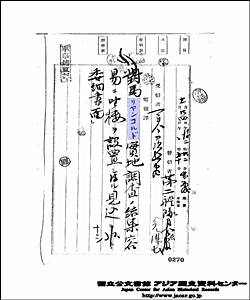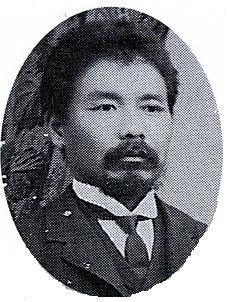 According to Japan’s MOFA’s Takeshima Brochure, “…Nakai Yozaburo was a resident of Oki Islands who aimed to stabilize his sea hunting business on Takeshima (Dokdo)..” and as a result, “…Japan reaffirmed its intention to claim sovereignty over Takeshima…” Put simply Japan’s whole claim rests on the activity of Nakai Yozaburo. (Nakai Yozaburo shown right)
According to Japan’s MOFA’s Takeshima Brochure, “…Nakai Yozaburo was a resident of Oki Islands who aimed to stabilize his sea hunting business on Takeshima (Dokdo)..” and as a result, “…Japan reaffirmed its intention to claim sovereignty over Takeshima…” Put simply Japan’s whole claim rests on the activity of Nakai Yozaburo. (Nakai Yozaburo shown right)
This following article is Nakai’s Biography written by Okuhara Hekiun (奧原碧雲). Both Nakai Yozaburo and Okuhara Hekiun accompanied the infamous Takeshima Inspection team that visited Ulleungdo in 1906 to announce Dokdo had been annexed. The biography reveals some interesting facts about Nakai Yozaburo’s background. It also gives insight into the manner and motives the Japanese Government used to seize Takeshima / Dokdo.
Was Nakai just a simple seal hunter residing in Saigo, Oki Island?
Meiji 39 (1906) Okuhara Hekiun (奧原碧雲)
Cover :「Record of Successful Takeshima Management by Nakai Yosaburo」, Meiji 39 (1906)
Okuhara Hekiun
「Record of Success」 Takeshima CEO Nakai Yosaburo’s Success Story by Okuhara Hekiun (奧原碧雲)
After 300 years of isolation from the country, they have not yet awakened from the old dream of Paradise(武陵桃源), and the benefits of the blue sea are futilely not taken care of so that outsiders may be trampled on. Set in the neighbor sea as the stage, recklessly relying on the protection of the gods and Buddhas to cast nets and gather fish families, as if wishing for an auspicious event, is it not really a disgrace for a sea man? In order to scold the waves and plan an expedition to a different area of 侵□□□□萬里 as the base of the fish family, or to find the 深潭□□□□□
A person like Nakai Yozaburo, a good boy from Sanyin prefecture, should be one of those people. He was born on the 28th day of the January first the Genji (元治) era (1864) in Nakagawara, Kogamo village, Tohaku-gun (formerly Kume-gun), Hoki country. His father is called Jinroku (甚六, now deceased), and his mother is called Ura (sister of Gyujiro Komoto(河本久次郞), Yasuda Village (安田) in the same county). He was the second son and the eldest was Chiro Kishi (喜七郞), and he succeeded his family business and was engaged in the brewing business.
After graduating from Shimoda Elementary School (下田小學校) in the 11th year of Meiji (1878), Mr. Yosaburo went to Matsue to study in Matsue(松江), and was taught by Yusuke Uchida (內田友輔), a great Confucian scholar, for several years. At the end of the 18th year of Meiji (1885), he went to Tokyo with a load of luggage and entered the Samun School (斯文黌).
A young man who grew up in a remote area in the mountains and was unaware of social trends, entered Tokyo after a long time, the center of his activities and was impacted by modern culture and contemporary thought. Chinese characters, which have been studied with great care and attention for many years, conform to the old conventions, and they are too friendly and too knowledgeable to try to make an outstanding performance in a lively society in the future. and he was too late to learn □□□□ English Studies from now on unfortunately, he spent his competent time in vain, and eventually he only had to learn male learning (男子) unfortunately.
However, the spirit of a young man who does not return after pulling his bow, saying that it would be foolish to throw away an opportunity of success for the sake of learning, like a ferocious horse freed from bondage, the 19th year of Meiji (1886), 23 years old I quit my studies and said, “There are green mountains everywhere, so why limit the place to bury our bones in our hometown? (人間到處有靑山, 埋骨何限鄕地)” aloud, and Nakai decided to find profit in the seas abroad.
This was a very reckless act, but it was part of his characteristics. Since then, Nakai had been planning various adventurous expeditions, looking for money on the Ogasawara Islands, or even trying to go to the United States.
While planning a trip to Australia with Shiga Shigetaka who traveled to southeast Asia boarding on the Warship Tsukuba (筑波艦) in Meiji 20(1887), and with the consent of his brother, he obtained thousands of yen for travel expenses and was preparing for a trip in Nagasaki (長崎), when an evil man named Kagasenri (笠千里) robbed him of all of his travel expenses.
He was unable to move here and was vainly confined to Matsushima(松島) near Nagasaki(長崎), where he discovered that sea cucumbers were abundant in Vladivostok, a Russian area. So, after planning diving machine collection, in Meiji 21, he consulted with his younger brother Yoshizo Yoshi and invested a large amount of money for research and preparation expenses, and soon afterward, he started a business.
So, when Nakai Yozaburo’s diving company in Nagasaki learned that sea cucumber harvesting in Vladivostok was quite promising, and since around Meiji 23, he payed great attention to the business and Mr. Nakai began to gather support from the Sugiura Store (杉浦商店), the largest Japanese store in Pohang harbor in Korea). By winning the prize, Nakai fought against the majority of Japanese residing in Russia as enemies, and he always won the championship.
As a result, he won the victory again, but after a while, Mr. Nihashi (二橋謙) the Trade Officer invalidated the result of the lottery, and his business suffered a devastating blow. His younger brother Gajo (嘉造) fell into the misfortune by losing all of his deceased uncle’s inheritance. Meanwhile, the Russian provincial office realized the benefits of sea cucumber harvesting and the harmful effects of submersible fishing, and after some time banned Japanese sea cucumber harvesting and submersible fishing.
In the 25th year of Meiji (1892), he collected the remnants of settling from Vladivostok and explored the coastal waters of Korea’s Jeolla-do and Chungcheong-do province, and wandered around with a submersible equipment, but there was no significant harvest. Nakai, a handsome boy of the sea, full of courage and enterprising spirit, had experienced setbacks and failures repeatedly, and was now 30 years old.
It was Meiji 26 (1893) when he was forced to return to his hometown in vain without finding a clue to his success. His heart can truly be counted. So, after returning home, he researched the seabed of his hometown and the coastal waters of his hometown, convinced that sea cucumber were there, so he resisted the enthusiastic advice of his friend and, by far, sent a fisherman from Kyushu to test it, and got good results. He finally invested money, and from Meiji 27-28 to around 30 years, Hakushu (伯州, 伯耆國) the western area of present-day Tottori Prefecture) Okiya(御來屋) was the base for Oki and Iwami coasts. He greatly expanded his business, and under the name of Nagasaki Sangbo(長崎商報) at the time, he was listed as a company under the name of Hakushu Sea Cucumber .
In Meiji 31,() he received subsidies from the Shimane and Tottori prefectural governments to take over the drawstring net test project, but due to some circumstances, the diver fishing business was temporarily suspended. His prosperous fishery business, however, was ultimately unsuccessful due to various strife. He was rejected by the staff and ended up squandering some of the funds raised by the submersible fishing industry. In addition, he lost credibility with the public and the setbacks since caused him to amass a lot of debt, which made it quite difficult. Every time he crossed a hurdle, his heart became stronger but he went boldly and paid attention to the benefits of the sea, and he suffered three or four setbacks.
However, he did not hesitate to move his residence to Saigo (西鄕), Oki Island (his present residence), and while he was busy planning a new business at the end of the dead end, he heard from a diver fisherman that sea lions were gathering on Liyangko Island (Dokdo). What he planned to do with a prosperous business in the sea was to focus on sea lion hunting.
Liyangko Island (Dokdo) is the name of Liankor Island, which was discovered by fishermen in Oki from 250 years ago and has since been known to the people of the coastal region as Matsushima (松島).
Since then, the island has been known as Liancourt Rocks. It is located at 37 degrees 9 minutes 30 seconds north latitude and 131 degrees 55 minutes 0 seconds east longitude, 85 nautical miles northwest of Oki Island, 55 nautical miles southeast of Ulleungdo, and is a rocky island in the center of the Sea of Japan. The West Islet is 381m above sea level and has a circumference of 15 町許 (unit of measurement), and the East Islet is 226m above sea level and has a circumference of more than 15 町許.
The islands are made of igneous rocks, and more than half of the islands are covered with light soil and weeds. The coastline is precipitous, with narrow sand and gravel areas on the east and west sides of the islands, where the two islands face each other. There is a narrow sand and gravel area on the East Islet, where temporary hunting shacks can be built. There is no drinking water and no crops on the islands, and they have been uninhabited for a long time.
In February of Meiji 38 (1905), it was renamed Takeshima and incorporated into the territory of Shimane Prefecture, and on May 28 of the same year, in the Battle of Japan, Admiral Togo’s announcement made the name Takeshima publicized all over the world. It was said that the soldiers of the defeated army were silent for several years.
Nakai Yozaburo’s entrepreneurial enthusiasm in the marine business was so strong that it was impossible to suppress it. In the 36th year of Meiji (1903), he again prayed for the sea lion catching business on Liyangko Island. However, all of his friends and acquaintances said that this was impossible, and especially, like Mr. Manodetsu Taro(眞野哲太郞), warned that it was very impossible. In spite of diligent advice from Tozen, Oki country, of trying to engage in a fishing industry and failing to do so, Nakai’s determination was firm and unshakable.
In May of Meiji 36, (1903) he sailed to Liyangko Island with two people, who were in agreement, Obara (小原) and Shimaya Kenjo (島谷權臧). The two of them, together with 8 strong men, boarded a fishing boat that was 2.5 meters wide and 7.2 meters long, and sailed through the great waves of the North Sea to reach the East Island. For the first time, the Japanese flag was flown over the rocks. Mr. Shimaya (島谷) made a report that it was promising and returned to port.
However, due to poor preparation of firearms, gunpowder and other difficult tools, Nakai returned to Japan without seeing sufficient success in the same year. The plan was to wait for the next year’s rebound and try to make a great harvest. In fact, Riyangko Island became a paradise of sea lions in the Sea of Japan, and tens of thousand of them come to the island to give birth and mate every year from around May to July to August. As a result, the rock formations were covered with a colony of sea lions, forming a spectacular sight.
Nakai secretly began preparations while wishing for the success of the next year in his heart. In May of 1903, Mr. Ohara and Mr. Shimatani Gonzo, who were in agreement with each other, were invited to Liancourt (Dokdo). Shimaya suffered great setbacks in business due to illness, but he did not give in and personally led the fishermen to the island. Thus, when the prospect of this project was detected, strong competitors such as Matsutaro Ishibashi (石橋松太郞), Ryuta Iguchi(井口龍太), and Shigejo Kato (加藤重藏) appeared, resulting in the evil of overfishing. Concerned that the sea lion fishery would be extinct within a few years, he felt the need to lease the area and restrict the harvest.
When referencing, according to a sea chart, the island belonged to the territory of Joseon (Korea) and there was no way to receive protection even if one encountered a foreign invasion. Nakai Yozaburo petitioned the Joseon government to lease the island and decided to monopolize it. He left for Tokyo with a dream of 10,000 gold pieces in his pocket.
He first approached Kantaro Fujita, (藤田勘太郞) an official of the Fisheries Bureau of the Ministry of Agriculture and Commerce from Oki. He met Director General Maki (牧) of the Fisheries Bureau and made a statement to him.
He agreed with this and first went to the Naval Hydrographic Department to ascertain the affiliation of Ryanko Island.When Nakai met with the Director of the Hydrographic Department, Kimotsuki, Nakai was told that there was no firm evidence the island belonged to Japan or Korea, and that if the distances between the two countries were measured, (108 nautical miles from Takohana in Izumo Province and 118 nautical miles from Cape Homi in Korea) the island was ten kilometers closer to Japan. In addition, there is no evidence of any Korean involvement in the management of the island (Dokdo). As long as there are Japanese nationals already engaged in the management of the island , it should naturally be incorporated into Japanese territory.
The three ministers of Home Affairs, Foreign Affairs, Agriculture and Commerce were then informed of the situation. Nakai then went to the Ministry of the Interior’s Regional Bureau and explained the situation.
In this way, Nakai appeared at the local bureau of the Ministry of Home Affairs and made a statement. The bureau stated that, as both Japan and Russia were currently at war, the time was not ripe for the incorporation of the territory from a diplomatic point of view. The Director-General of the Maki Fisheries Bureau was again informed that the application should be rejected by the regional authorities, so he had no choice. Thus, Nakai Yozaburo was disappointed when he was told that there was nothing he could do about it because it was a diplomatic matter.
At the time, Shimane Prefecture Governor Ihara (井原) was on his way to Tokyo with Mr. Fujita Yukitoshi (藤田行年), the head of the Ministry of Agriculture and Commerce, to attend a local government meeting. Governor Ihara visited FujitaYukitoshi and discussed the issue of Nakai’s petition. He agreed greatly and promised the need to report in detail to the local authorities. Nevertheless, Fujita said that he (Nakai) had no hope of success, and had no choice but to wait for the right time to return home.
Right now, with a promising business in front of Nakai, he may have missed the timing of management while waiting because Riyangko’s (Dokdo’s) ownership was not clear. Moreover, considering that over fishing has taken place over many years and the future of the partnership was very worrying, it was understandable that Nakai Yozaburo was truly heartbroken.
However, Nakai had made up his mind. He discussed it with Kuwata Kumajo (桑田熊藏), from Nakai’s same home town. Kuwata Kumajo, who was now a high-income taxpayer, said he should be determined to overcome a hundred hardships.
Dr. Kuwata immediately wrote a letter and introduced him to Yamaza Enjiro, the Director of Political Affairs. Mr. Nakai visited Director Yamaza and gave his opinion on the management of Riyangko Island, and although he was full of enthusiasm, it seemed that there were still decisions. After the director listened with interest, he stated, minor incidents such as the incorporation of a small rocky island, are not for anyone else to get involved in. Yamaza also acknowledged that the current territorial incorporation would be very beneficial from the standpoints of topography, history, or current affairs.
From this point on, Kuwata Kumajo also accompanied him to the Ministry of Home Affairs and visited Secretary Inoue to explain the situation. Finally, after obtaining the consent of the Ministry of Home Affairs, on February 22, Meiji 38 (1905), Shimane Prefecture Notice No. 40, incorporated Riyangko and named it Takeshima (竹島).
After returning home, Mr. Nakai gradually prepared a plan, but when the case of territorial incorporation was finally announced, Shimane Prefecture’s jurisdiction was declared over the fishery lease (of Dokdo). Competitors arose one after another, and many applicants appeared outside few of the previous applicants, making it difficult for Shimane Prefectural Office to adopt it (Nakai’s exclusive lease of Dokdo).
Mr. Nakai formed the Takeshima Fishing Joint Stock Company in cooperation with Tomojiro Hahaoka (橋岡友次郎), Ryuta Iguchi (井口龍太), and Shigejo Kato (加藤重蔵). With permission from the current governor Matsunaga (松永), sea lion hunting rights on the island were returned to possession of Mr. Nakai and three others. By protecting the young, limiting the number of captives, making plans for the future, and based on years of experience in the sea and years of experimentation on sea lion catching, from that year on, Nakai wanted to focus on the management of Takeshima Island (Dokdo) and should reputed as hero of the sea.
Annex: This spring, as a member of the Takeshima inspection team, I had an evening meeting with Mr. Nakai and listened to his troubled management story, and I was intrigued. He came back and wrote the main story, thinking about the time when he held hands on the deck of Oki Maru (ship) and prayed for his success.
May 20, Meiji 39 (1906)
From Nakai Yozaburo’s diary:
Shiga revered Charles Darwin. Thus he voyaged like Darwin’s HMS Beagle did. Aboard the Japanese Warship Tsukuba (筑波艦) in 1885, Shiga witnessed the British occupation of Korea’s Goemundo Island which left an impression on him. With permission from the Japanese Navy, Shiga again voyaged board the Tsukuba in 1887 through the South Pacific, Australia and New Zealand.
“…Every year on the anniversary of Emperor Jimmu’s accession, February 11, and on the anniversary of his passing, April 3… we should ceremonially increase the territory of the Japanese empire even if only it is by a small measure. On each of these days our navy vessels should sail to a still unclaimed island, occupy it, and hoist the Japanese flag . . . Not only would such a program have direct value as practical experience for our navy, but it would excite an expeditionary spirit in the demoralized Japanese race…”
Other things stand out in this small excerpt. The Japanese Government, through the Navy promoted exploration, fishing and settling to expand their empire and would often allow passage for civilians.
Also note, Nakai Yozaburo in Meiji 20 (1887), had secured thousands of yen for his failed adventure. In today’s money that’s a tidy sum! Indeed, Nakai Yozaburo was no humble seal hunter…
“…So, when his diving company in Nagasaki learned that sea cucumber harvesting in Vladivostok was quite promising and since around Meiji 23, he payed great attention to the business…”
“…In the 25th year of Meiji (1892), he collected the remnants of settling from Vladivostok and explored the coastal waters of Chosun (Korea’s) Jeolla-do and Chungcheong-do provinces, and wandered around with a submersible equipment, but there was no significant harvest…”
“…He finally invested money, and from Meiji 27-28 to around 30 years, Hakushu (伯州, 伯耆國) the western area of present-day Tottori Prefecture) Okiya (御來屋) was the base for Oki and Iwami coasts…”
“…However, he did not hesitate to move his residence to Saigo (西鄕), Oki Island (his present residence)…”
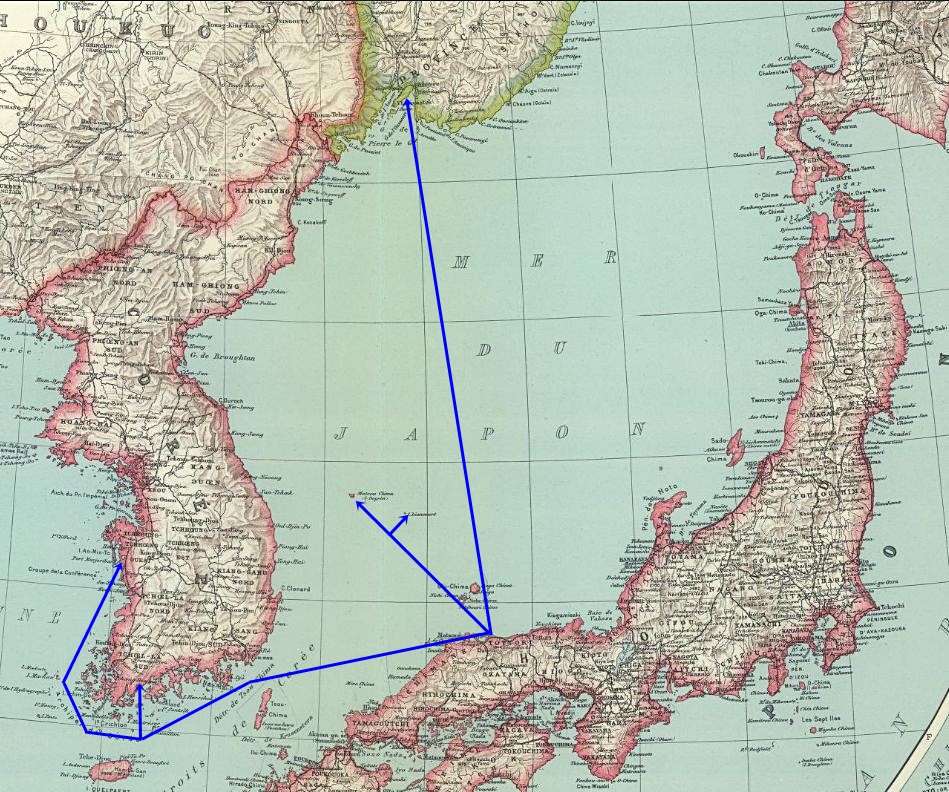 At an early age Nakai Yozaburo became obsessed with voyaging afar to strike it rich. In his own words “..Nakai left for Tokyo with a dream of 10,000 gold pieces in his pocket…” Like many Japanese, he hoped to make a profit in the Ogasarawa Islands (小笠原諸島) he was even willing to take a chance on the U.S. or Australia. However, as each of his endeavors failed he was driven back. From Russia’s Vladivostok, to Korea’s Chung-Cheon and Cholla Provinces, to Hakushu then Saigo, Oki Island, Nakai Yozaburo voyaged literally thousands of kilometers. (click map right)
At an early age Nakai Yozaburo became obsessed with voyaging afar to strike it rich. In his own words “..Nakai left for Tokyo with a dream of 10,000 gold pieces in his pocket…” Like many Japanese, he hoped to make a profit in the Ogasarawa Islands (小笠原諸島) he was even willing to take a chance on the U.S. or Australia. However, as each of his endeavors failed he was driven back. From Russia’s Vladivostok, to Korea’s Chung-Cheon and Cholla Provinces, to Hakushu then Saigo, Oki Island, Nakai Yozaburo voyaged literally thousands of kilometers. (click map right)
Finally, Nakai’s dreams were reduced to trespassing on Korea’s Ulleungdo along with other Japanese undesirables. It was illegal to fish Korea’s waters unless the catch was declared and taxed in Busan. Through his illicit activities en route to Korea’s Ulleungdo Island, Nakai became familiar with Dokdo. Later, Nakai would even travel as far as the Kurile Islands to make profit. (See maps below) However in January of 1914, Sea Lion and Seal Hunting in the Northern Kuril Islands were prohibited.
“…From this point on, Kuwata Kumajo also accompanied him to the Ministry of Home Affairs or to explain the situation. Finally, after obtaining the consent of the same Ministry, and on February 22, Meiji 38, Shimane Prefecture Notice No. 40 incorporated Riyangko and named it Takeshima (竹島)…”
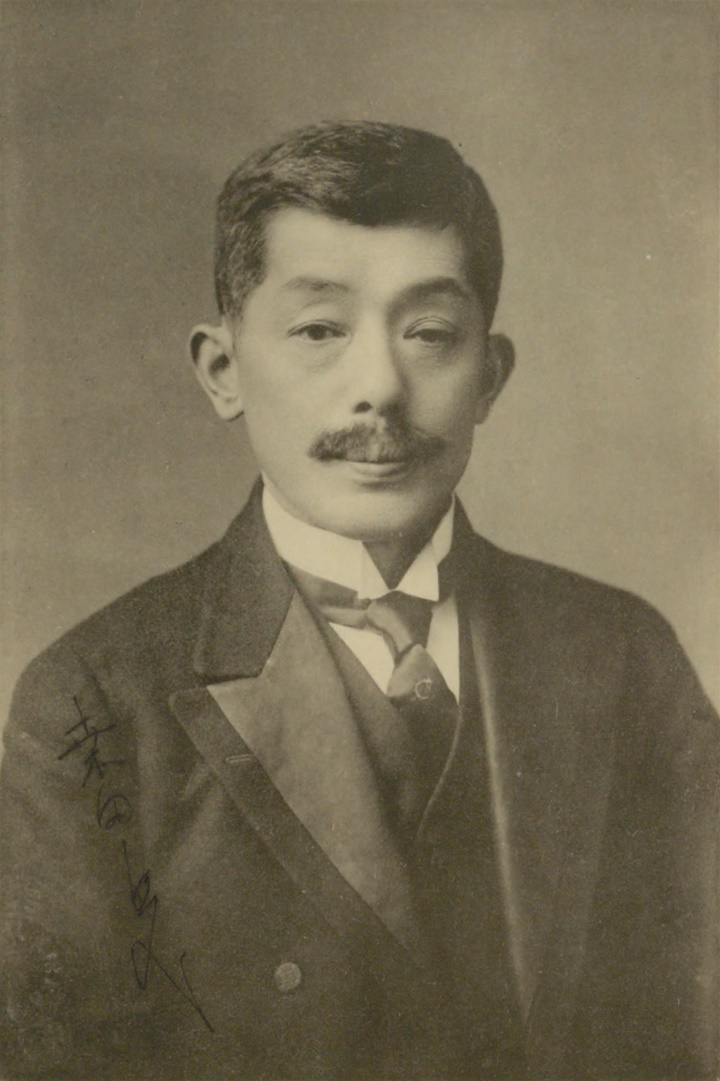 Nakai’s luck took a turn for the better through an acquaintance named Kuwata Kumajo. Nakai and Kuwata were both from the same hometown (region of Tottori) and about the same age. Kuwata was highly educated graduating from the Law College of the Imperial University in of Tokyo in1893 and also studied social issues in Europe. Kawata was a rising star in Japanese politics, in fact he would be selected as a Member of the House of Peers as a high paying taxpayer in September of 1904.
Nakai’s luck took a turn for the better through an acquaintance named Kuwata Kumajo. Nakai and Kuwata were both from the same hometown (region of Tottori) and about the same age. Kuwata was highly educated graduating from the Law College of the Imperial University in of Tokyo in1893 and also studied social issues in Europe. Kawata was a rising star in Japanese politics, in fact he would be selected as a Member of the House of Peers as a high paying taxpayer in September of 1904.
Being familiar with politics, Kawata Kumajo guided Nakai through the political system. He first introduced Nakai to the Secretary of Home Affairs and then the Minister of Home Affairs himself. This was important, as it was the Ministry of Home Affairs that ultimately ‘incorporated’ Dokdo (Takeshima) even though in 1877 the same ministry determined both Ulleungdo and Dokdo were Chosun territory. The 1877 Kobunruko Documents
Kawata Kumajo also introduced Nakai to Yamaza Enjiro the Director General of Political Affairs.
One short sentence of this diary exposes Japan’s true reasons for ‘incorporating’ Dokdo. Yamaza Enjiro stated it was beneficial to incorporate the island (Dokdo) because of the “…current situation…” What was the “current situation”?
At this time the Japan~Russo naval battles raged in the waters surrounding Ulleungdo and Dokdo. Nakai Yozaburo would elaborate further on his discussion with Yamaza Enjiro another interview titled ‘中井養三郎 「事業経営概要」’ (Nakai Yozaburo, Business Management Summary) Below is Yamaza Enjiro’s exact quote from Shimane Prefecture’s Website.
“…As a result, I immediately went to the Ministry of Foreign Affairs and asked Mr. Enjiro Yamaza, the then Director General of the Political Affairs Bureau, for his advice. Mr. Enjiro Yamaza, the then Director General of the Ministry of Foreign Affairs, was very much involved in the discussion, and he stated that the incorporation of the island into Japan’s territory was an urgent necessity due to the current situation (Russo-Japanese War) and that the construction of a watchtower, a radio station, and a undersea telegraph were necessary to monitor enemy vessels…”
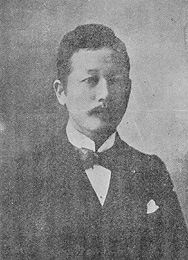 Who was Yamaza Enjiro?
Who was Yamaza Enjiro?
A diplomat born in Fukuoka, he was the son of an ashigaru (a samurai of the lowest rank) for the Kuroda Clan. In 1892, he graduated from the Law College of the Imperial University. He then entered the Foreign Ministry and served as resident staff in Pusan, Shanghai, Incheon, London, and Korea. In 1901, he became the director of the Political Affairs Bureau. Under the foreign minister Jutaro Komura, he was involved in forging the Anglo-Japanese Alliance, negotiations with Russia, and diplomacy concerning the war against Russia. He also attended the Portsmouth Peace Conference as one of the staff in attendance, thus playing a central role in the Komura Diplomacy.
Director Yamaza Enjiro was known to have been under the influence of the nationalist, rightist organization of the Genyosha. The Genyosha was a terrorist organization, recruited disaffected ex-samurai, it also attracted figures involved in organized crime to assist in its campaigns of violence and assassination against foreigners and liberal politicians.
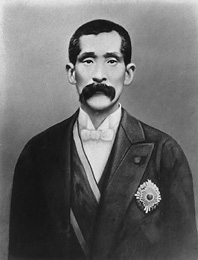 As Nakai’s dairy points out the Home Ministry was against annexing Dokdo. As mentioned, Japan had a hands-off policy regarding both Ulleungdo and Dokdo since 1877. However, the Home Ministry abruptly changed their minds. Foreign Affairs Minster Komura Jutaro shown right.
As Nakai’s dairy points out the Home Ministry was against annexing Dokdo. As mentioned, Japan had a hands-off policy regarding both Ulleungdo and Dokdo since 1877. However, the Home Ministry abruptly changed their minds. Foreign Affairs Minster Komura Jutaro shown right.
What made the Home Ministry do an about-face?
More excerpts from Nakai Yozaburo’s Personal Diary of 1910 ( Shimane Prefecture’s Materials on Takeshima) reveal the circumstances behind the Home Ministry’s sudden change of heart.
“Accordingly, I submitted an application through the three ministers of Home Ministry, Foreign Ministry and Agriculture-Commerce Ministry for incorporation of this island into Japanese territory and for its lease to me.
The Home Ministry authorities had an opinion that the gains would be extremely small while the situation would become grave if the acquisition of a barren islet suspected of being Korean territory a this point of time (Russo-Japanese War) would amplify the suspicions of various foreign countries that Japan has an ambition to annex Korea. Thus my petition was rejected.
Undaunted, I rushed to the Foreign Ministry to discuss the matter in detail with the then Political Affairs Bureau Director Yamaza Enjiro. Particularly in terms of diplomacy, he told me not to worry about the Home Ministry view. He asked me in high spirits to urge the Home Ministry to refer his application speedily to the Foreign Ministry: in this way Takeshima (Dokdo) came under our country’s dominion…”
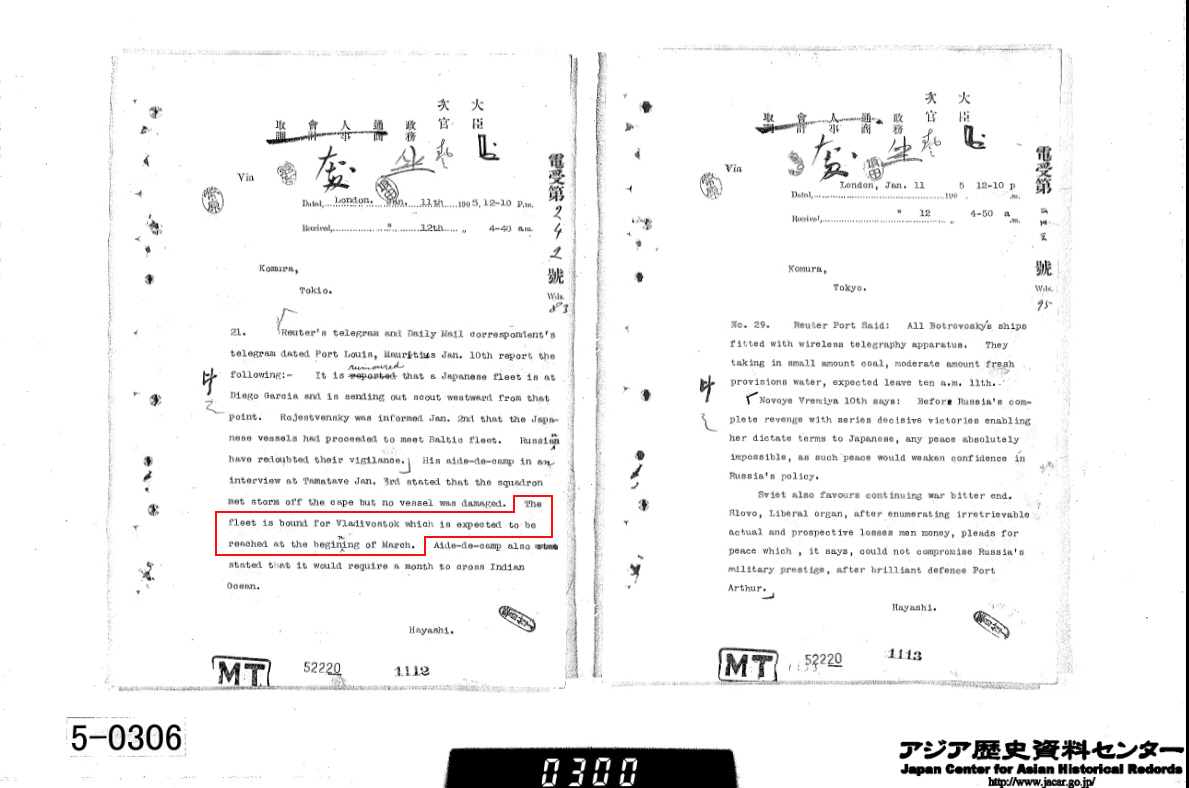 Seemingly, it was the Foreign Ministry’s Komura Jutaro who pushed hard to incorporate Takeshima. A particular record of importance could explain Komora Jutaro (and Kimotsuki Kaneyuki’s) urgent need to annex Dokdo and it had nothing to do with hunting seals. At this time, it became known Russia’s Baltic Fleet must pass Takeshima’s surrounding waters as Port Arthur had just fallen to Japan. See this link It was expected that the Baltic Fleet would be steaming past Takeshima to Vladivostok in March. (click right image.)
Seemingly, it was the Foreign Ministry’s Komura Jutaro who pushed hard to incorporate Takeshima. A particular record of importance could explain Komora Jutaro (and Kimotsuki Kaneyuki’s) urgent need to annex Dokdo and it had nothing to do with hunting seals. At this time, it became known Russia’s Baltic Fleet must pass Takeshima’s surrounding waters as Port Arthur had just fallen to Japan. See this link It was expected that the Baltic Fleet would be steaming past Takeshima to Vladivostok in March. (click right image.)“..He first approached Kantaro Fujita, (藤田勘太郞) an official of the Fisheries Bureau of the Ministry of Agriculture and Commerce from Oki. He met Director General Maki Makoto (牧 朴真) of the Fisheries Bureau and made a statement to him…”
The year in which Nakai received subsidies from the Shimane and Tottori governments is not coincidental. 1898 was the same year the Japanese deep sea fishing promotion laws were implemented. Also not surprising, in 1899 the aforementioned Director of Agriculture and Fisheries, Makoto Maki (牧 朴真) would inspect Korea’s coastal areas for one month starting in June 1899.
From there, Japanese Prefectures would form fishing cooperatives and swarm Korean coastal waters.
 The Background of Makoto Maki (牧 朴真)
The Background of Makoto Maki (牧 朴真)
Born in Shinken, Shimabara-mura, Minamitakarai-gun, Hizen Province (now Shimabara City, Nagasaki Prefecture) as the eldest son of Shinsei Maki, a samurai of the Shimabara domain. Maki had long career in politics including working for Japan’s War Ministry.
In November 1898, Maki was appointed Director General of the Fisheries Bureau of the Ministry of Agriculture and Commerce, and further served as Director General of the Agricultural Affairs Bureau. He later served as President of the Dainippon Fisheries Association, President of the Japan Canners Association, President of the Dainippon Fisheries Crafts Association, and Vice President of the Dainippon Fisheries Association, and devoted himself to the promotion of the fishing industry.
It’s not surprising given Maki’s career in Japan’s War Ministry and Imperial Japan’s Fishing Industry, he would support annexing Dokdo (Takeshima) to expand Japan’s territorial waters.
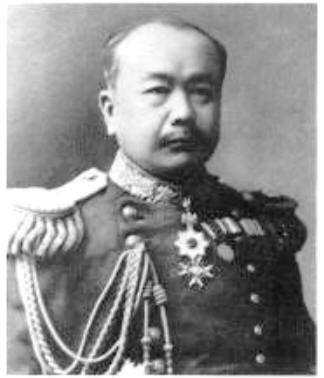 It’s the opinion of this author that the Director of Japan’s Hydrographic Department was the driving force behind Japan’s annexation of Dokdo (Takeshima). Let’s dig into his background.
It’s the opinion of this author that the Director of Japan’s Hydrographic Department was the driving force behind Japan’s annexation of Dokdo (Takeshima). Let’s dig into his background.
Kimotsuki Kaneyuki (肝付兼行), was a director of Hydrographic Department, and a mayor of Osaka, was born in Kagoshima (鹿児島) in 1853. The term Hydrographic Department is a bit misleading. Initially the Hydrographic Department was part of the Japanese Navy. Later the Hydrographic Department would become separate however it remained a military division providing the Japanese navy with vital strategic and logistical support.
Kimotsuki Kaneyuki devoted himself to a nautical surveys of Japan’s coasts. Concerning the selection of places of Imperial Naval Bases, the survey team led by Lieutenant Commander Kimotsuki carried out hydrographic surveys at Kure and Sasebo in 1883. As the head of the department, he had the authority to decide the locations of both commercial and naval ports. Because of Kimotsuki’s expertise, Kimotsuki Kaneyuki was regarded as an authority with primary information on the selection of military and commercial port locations.
Given Kimotsuki’s extensive role in the surveying, strategy and military knowledge it is not a stretch to say he was a father’s of the Japan’s modern navy. After all, Kimotsuki was instrumental in choosing the locations of two of Japan’s largest naval bases still in use today.
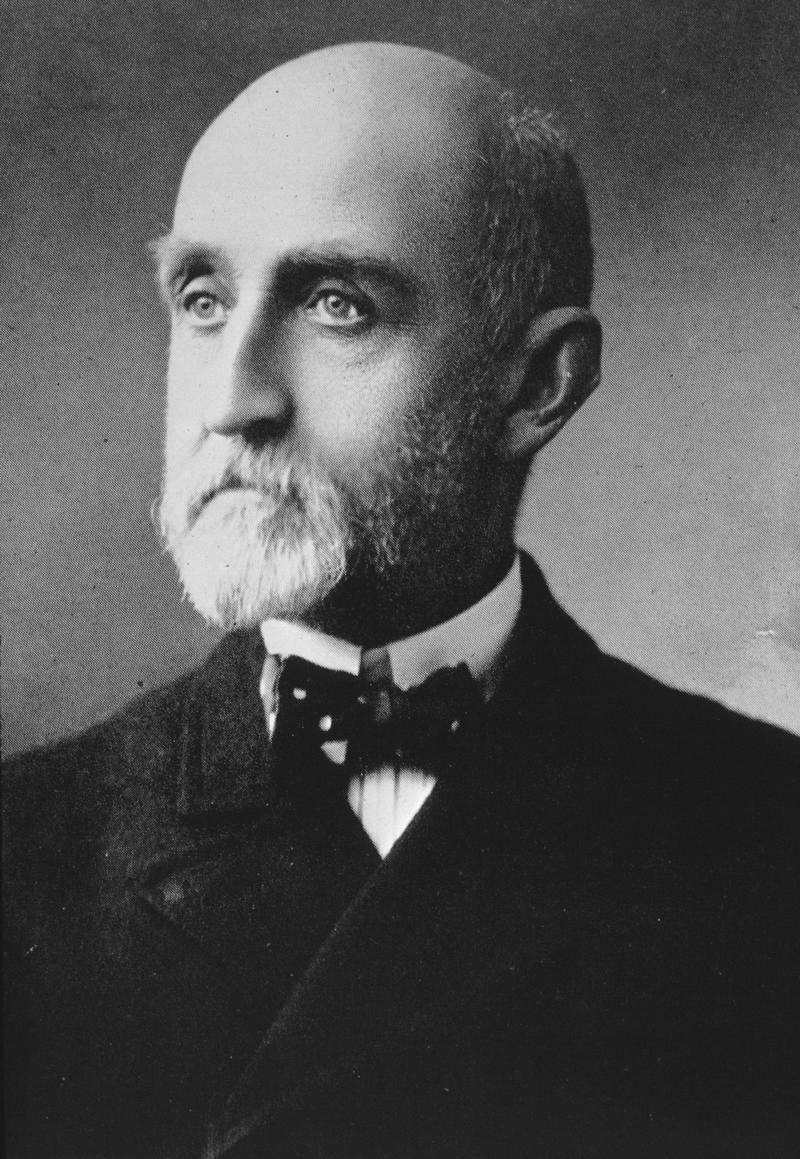 Alfred Thayer Mahan was a United States Naval Officer and historian, often regarded as the most important American strategist of the nineteenth century.
Alfred Thayer Mahan was a United States Naval Officer and historian, often regarded as the most important American strategist of the nineteenth century.
Mahan believed that national greatness was inextricably associated with the sea, with its commercial use in peace and its control in war and he used history as a stock of examples to exemplify his theories, arguing that the education of naval officers should be based on a rigorous study of history. Mahan’s framework emphasized strategic locations as well as quantifiable levels of fighting power in a fleet.
Mahan’s book ‘The Influence of Sea Power Upon History’ won immediate recognition, especially in Japan. The book was translated into Japanese in in 1896, a translation was funded by, and distributed to, the Suikōsha, the naval officers’ professional organization, and was used as a textbook in the Imperial Japanese Navy (IJN). As Mahan himself noted, more of his works were translated into Japanese than into any other language. That usage strongly affected the IJN’s plan to end Russian naval expansion in the Far East, which culminated in the Russo-Japanese War of 1904–05.
Kimotsuki, like most high ranking Japanese Naval Officers, was an ardent proponent of Alfred Thayer Mahan’s ‘Sea Power’ theory. Kimotsuki’s originality was in using Mahan’s Sea Power Theory from the sphere of public relations such as speeches as well as naval strategy. Kimotsuki also lectured throughout Japan on the maritime imperialist ideology of Sea Rights Theory based on Mahan’s Sea Power Theory. He favored a maritime imperialist policy that understood Japan’s development in relation to its control of the sea. Kimotsuki through Mahan’s logic figured Japan’s Empire should rule over the Seas surrounding Japan in much the same way the British controlled the Mediterranean.
Quote by Kimotsuki Kaneyuki:
“…What is the Mediterranean Sea in the Orient? The East Sea, the Yellow Sea, and the Sea of Japan are the Mediterranean Sea of the Orient. The Empire of Japan, which occupies the three most important maritime zones in the Mediterranean Sea, should be the protagonist of the Orient with its dominion..”
In other words, Kimotsuki applied Alfred Thayer’s Mahan’s Sea Power and adapted its strategy for the Russo-Japanese War. Having an intimate knowledge of the Sea of Japan and being an expert strategist it was only natural for Kimotsuki to militarize Dokdo.
Secret directive number #276 was wired to the Japanese Warship Tsushima on November 13th with explicit instructions to survey Dokdo. There really was no need for the Hydrographic Department to survey Dokdo. Maps show Japan’s Navy’s Hydrographic Department had mapped Dokdo’s location and form since at least 1876. This survey was for construction of military watchtowers and communications lines. A medical officer was also dispatched to analyze Dokdo’s water. Obviously, this survey was purely military in nature.
“..But how do we know Kimotsuki was involved with this process..?”
On January 5th 1905, the results of the survey for construction of naval watchtowers and telegraph station were completed by the Warship Tsushima’s Capt Saedo Taketaeru. The report was submitted to none other than the Director of the Hydrographic Department (水路部長) Kimotsuki Kaneyuki. It’s worthy to note, the survey report from Saedo Taketaeru also included a map that marked potential construction sites, water sources and the range of visibility from different vantage points on Dokdo.
The Logbooks of the IJN Warship Tsushima
Importantly the above military acts were conducted months before Japan annexed Dokdo Island showing military intent was Japan’s motivation for pushing through the annexation of Dokdo.
Dokdo and the Telegram by Japan’s Warship Izumi – 和泉艦
Nakai was a transient diver who ventured thousands of kilometers even illegally into Korean territory hoping to get rich. Nakai Yozaburo ventured as far as Korea’s Cholla and Chung Cheon Provinces. However, this was illegal, as fishermen were required to report their catch and pay taxes through the Japanese consulate in Busan and receive licenses. The Japanese government tacitly supported these outlaws. Nakai was not your typical fisherman. He had money and even financial support (subsidies) from the Japanese government. This helped fund his illegal incursions into Korean territory. Japan’s Fisheries Departments also backed Nakai and other fishermen to swarm Korean waters en masse.
Nakai had political guidance through local acquaintances. It was a hometown friend that would introduce Nakai Yozaburo to other influential politicians. Starting with Kuwata Kumajo, to Yamaza Enjiro, up to Komura Jutaro and Hydrographic Director Kimotsuki. Although the Home Ministry disapproved of annexing Dokdo – Takeshima, the Foreign Affairs Department forced through Nakai’s application with the backing of Japan’s Navy Brass.
Japan’s incorporation of Dokdo was for military purposes. Records and maps show Japan’s had known of Dokdo for a very long time. In fact numerous records show Japan consistently either excluded Dokdo from Japanese territory or considered the island as Korean. Japan had no interest in Dokdo (Liancourt Rocks) until immediately after the Naval Battle of Ulsan of the Russo-Japanese War. Military records from Japan’s National War Records show a sudden interest in Dokdo starting in September 1904 and this was no coincidence.
Despite Japanese assertions Dokdo was incorporated on behalf of a seal hunter from Oki Island, Nakai Yozaburo’s own diary proves otherwise. With historical context and related primary historical records a more plausible motive for Japan’s annexation is Japan’s ambition to colonize Korea. Japan should finally admit its annexation of Dokdo (Takeshima) in 1905 was an act of greed and violence, and drop her claim to Dokdo. This act would be a huge step forward in Korean ~ Japanese relations.
KIMOTSUKI Kaneyuki, A Public Relations Expert of IJN by Rikiei Shibasaki
Reflections on Kimotsuki Kaneyuki (肝付兼行) by Kim Yeong

